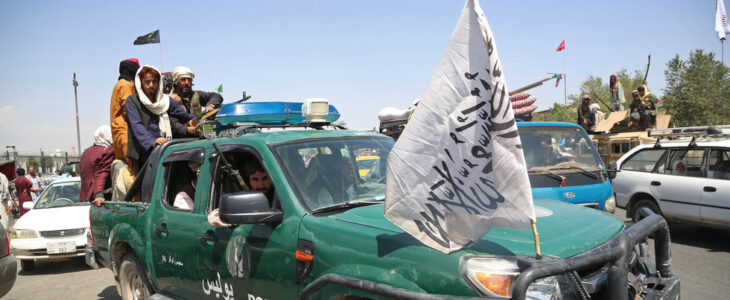
Joe Biden vowed an orderly withdrawal of US troops from Afghanistan and expressed faith in government forces. Barely two months on, the Taliban have overrun the country and ousted its president. How did things deteriorate so fast?
The US invaded Afghanistan in 2001 following the 9/11 terrorist attacks, ostensibly to fight Al-Qaeda and other jihadist groups. The Western coalition quickly expelled the Taliban from major cities, but the insurgency never stopped – and war raged for two decades.

February 2020
The Trump administration signs a peace deal with the Taliban in Qatar, agreeing to withdraw its forces from Afghanistan within 14 months. The militants promise not to attack Americans and their allies and open a dialogue with Kabul. Nevertheless, the fighting resumes almost immediately.
April 14, 2021
With President Joe Biden now in office, the US announces American troops will leave Afghanistan by September 11 – extending Trump’s previous plan for an exit by May.

“We cannot continue the cycle of extending or expanding our military presence in Afghanistan – hoping to create ideal conditions for the withdrawal and expecting a different result,” Biden declared.
He said US forces cannot remain in the country forever and must not be used as “a bargaining chip between warring parties.”
Two weeks later, the Taliban launches a major offensive in the southern Helmand Province. The assaults will only intensify from there, while attempts to revive peace talks fail.
July 8, 2021
Biden announces that the US military mission in Afghanistan will end on August 31, two weeks ahead of his initial deadline. The statement was made days after American soldiers left Bagram Air Base, the Pentagon’s largest outpost in Afghanistan.
Asked by a reporter if the Taliban takeover of the country is inevitable, Biden replies simply: “No, it is not.” He praises the US-trained Afghan Army, saying it is “as well-equipped as any army in the world.”
Timeline of Taliban advance in Afghanistan: from the very beginning to the capture of KabulREAD MORE: https://t.co/QWDsDEEWmapic.twitter.com/ajqWsBYVrH— RT (@RT_com) August 16, 2021
Biden also rejects earlier reports by US media that his own intelligence team concluded that the Afghan government could collapse as soon as six months after withdrawal. It would not even take that long, however.
Taliban militants quickly gain ground in northern parts of the country, forcing some 1,500 government troops to flee into Tajikistan.
Washington ramps up airstrikes against Taliban to support embattled government forces, but they prove to be ineffective.
August 2, 2021
President Ghani blames the “abrupt” withdrawal of the US-led forces for his country’s deteriorating security situation
A Taliban spokesperson responds by warning Ghani that “his time is over.”
August 6-8, 2021
The seemingly unstoppable militants begin to rapidly seize provincial capitals, which fall like domino chips.
August 10, 2021
The Washington Post and ABC News report that the Pentagon believes Kabul could fall anytime within 30 to 90 days. “Everything is moving in the wrong direction,” an unnamed official is quoted as saying by the Post.
The Taliban captures a strategic road juncture to the north of Kabul and encircles the capital.
August 12-14, 2021
The US sends 3,000 soldiers and marines to watch over the evacuation of American diplomatic staff, as the Taliban seizes the major cities of Kandahar, Herat, and Mazar-i-Sharif.
August 15, 2021
The Taliban enters Kabul virtually unopposed, takes control of the presidential palace in Kabul, and declares victory.
Ghani flees the country, saying he did so to prevent the Taliban “massacring” civilians. Meanwhile, locals rush to the city’s airport in hopes of catching the last plane out of Afghanistan. Commercial flights would be officially suspended on Monday.
US Army helicopters evacuate Americans from the embassy, drawing comparisons to the iconic images of the 1975 evacuation of Saigon shortly before the capital of South Vietnam fell to the Viet Cong. State Secretary Antony Blinken rejects such grim comparisons: “Remember, this is not Saigon.”
Credit: RT News
